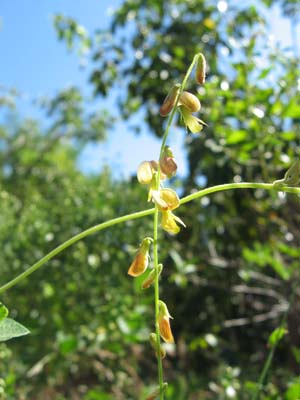Plants of South Florida · Plants by Conservation Area · Plants by County · Plants by Habitat Quick Search · Advanced Search |
||
|
|
||
 |
Rhynchosia swartzii (Vail) Urb. Swartz''s snoutbean |
|
|
South Florida Status: Critically imperiled. Three occurrences in six conservation areas (Biscayne National Park; Crocodile Lake National Wildlife Refuge, Dagny Johnson Key Largo Hammocks Botanical State Park, & John Pennekamp Coral Reef State Park; Key Largo Ansama Parcel, Florida Keys Wildlife and Environmental Area & Dove Creek Hammocks, Florida Keys Wildlife and Environmental Area). Taxonomy: Dicotyledon; Fabaceae. Habit: Vine. Distribution: Native to South Florida and the West Indies. South Florida Distribution: Miami-Dade County and the Monroe County Keys. South Florida Habitats: Rockland hammocks. Protection Status: Listed as endangered by FDACS and as critically imperiled by FNAI. Aids to Identification: Unlike other trifoliate Rhynchosia in South Florida, R. swartzii has red seeds (Wunderlin, 1998). References: Chapman, 1883; Small, 1933a; Long & Lakela, 1976; Grear, 1978; Correll & Correll, 1982; Isely, 1990; Wunderlin, 1998; Coile, 2000. Synonyms: R. caribaea D.C., misapplied; Dolicholus swartzii Vail. Historical Context: Swartz’s snoutbean was collected first on the island of Key West by either John Loomis Blodgett between 1838 and 1853 (s.n., NY) or by Ferdinand Rugel in 1846 (137, FLAS, NY). These remain the only known collections from the lower Florida Keys. In 1906, John Kunkel Small and Joel J. Carter collected Swartz’s snoutbean on Elliott Key in Miami-Dade County (2550, NY), which is now part of Biscayne National Park. It has been observed there by the authors as recently as 2001. Small and Charles A. Mosier also collected it in 1915 on Adams Key (5728, NY), also in Biscayne National Park, but surveys by Gann and Bradley in 2001 failed to locate any plants. Swartz’s snoutbean has been collected a few miles to the south on Key Largo by many botanists. The first to collect it were Small and Carter in 1909 (2958, NY), on the southern portion of the island. Bradley and Woodmansee observed it in Dove Creek Hammocks in the Florida Wildlife and Environmental Area on southern Key Largo in 2000. In 2001, Bradley and Woodmansee also observed one plant at the Key Largo Ansama Parcel, Florida Keys Wildlife and Environmental Area. Both of these stations need to be vouchered. All other reports are from the northern portions of Key Largo, from about two miles south of the junction of US 1 and State Road 905, to the northern tip of the island. It was collected first on northern Key Largo by E.F. Ford in 1961 (s.n., FLAS). It has been observed as recently as 2000 by Bradley and Woodmansee at Crocodile Lake National Wildlife Refuge, and by Gann and Florida Park Service biologist Janice A. Duquesnel at Dagny Johnson Key Largo Hammocks Botanical State Park and John Pennekamp Coral Reef State Park. The populations in these three sites are all considered as one occurrence. Bradley vouchered plants at Dagny Johnson Key Largo Hammocks Botanical State Park in 1995 (475, FTG), and Bradley and Woodmansee vouchered plants at Crocodile Lake National Wildlife Refuge in 2000 (1248, FTG). Plants at John Pennekamp Coral Reef State Park still need to be vouchered. There is a single report from privately owned Teatable Hammock on Upper Matecumbe Key (Weiner, 1980 as amended). Only one record is known from the mainland. George N. Avery found Swartz’s snoutbean in 1976 in “Lower Loveland Hammock” in southern Miami-Dade County (1667, USF). According to his description of this location, it appears that this station is now called Grant Hammock, which is privately owned. The western half of this hammock has been mostly destroyed, but it appears that Avery found plants at the eastern edge of the hammock. Major Threats: Exotic pest plant invasions; management error. Comments: This species often grows at the edges of hammocks, thus it is susceptible to trimming or herbicide treatment of forest edges. Recommendations: • Voucher plants at Dove Creek Hammocks, John Pennekamp Coral Reef State Park, and Key Largo Ansama Parcel. • Survey Grant Hammock. Continue surveys on Adams Key. • Map and monitor known stations on a regular basis. • Consider reintroduction to Key West at Little Hamaca Park, and to other locations within its historical range. |
||



